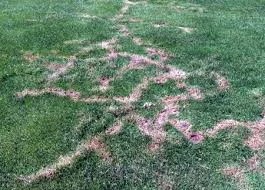What homeowner doesn’t dream of a perfect smooth emerald-green lawn in front of the house? However, your beautiful dream may be overshadowed by one significant problem.
Moles! These creatures are perfect diggers and are able to dig as fast as a foot per minute. As you can imagine, this is an advantageous way of soil aerating. On the other hand, moles are leaving visible furrows, damaging plants.
Their tunnels push up the earth breaking your lawn’s harmony and they eat earthworms so advantageous for the soil.  If you noticed the first furrows and suspect moles, it is obvious that it’s better to get rid of these skillful diggers better sooner than later. But to combat them, we must know a little about our enemy. All moles can be damaging, but the Eastern mole is by far the most widespread. It is better described as the common or grey mole. This mole is the strongest of the group and is most often associated with tunnels and or mole mounds by residential homeowners. Moles are not rodents, but belong to a group of mammals called insectivores. Moles have a very high metabolic rate and, therefore, have to consume large amounts of food. Moles have large appetites and may eat up to 100 percent of their body weight in one day. White grubs, earthworms, beetles, and assorted larvae are their principal foods. Moles feed primarily on insects that feed below the ground.
If you noticed the first furrows and suspect moles, it is obvious that it’s better to get rid of these skillful diggers better sooner than later. But to combat them, we must know a little about our enemy. All moles can be damaging, but the Eastern mole is by far the most widespread. It is better described as the common or grey mole. This mole is the strongest of the group and is most often associated with tunnels and or mole mounds by residential homeowners. Moles are not rodents, but belong to a group of mammals called insectivores. Moles have a very high metabolic rate and, therefore, have to consume large amounts of food. Moles have large appetites and may eat up to 100 percent of their body weight in one day. White grubs, earthworms, beetles, and assorted larvae are their principal foods. Moles feed primarily on insects that feed below the ground.  The tunnels that the mole excavates while searching for food may be used only once or may be traveled repeatedly.
The tunnels that the mole excavates while searching for food may be used only once or may be traveled repeatedly.
Moles may be active during any time of the day and seem to prefer cool, moist soil (the same as that preferred by grubs and earthworms). Moles do not eat the roots and bulbs of flowers and vegetables, a commonly held belief. Moles mate during the months of February and March. They produce a single litter of three to five; gestation period is six weeks. Moles do not hibernate and store food or fat. Severe lawn damage can result until mole control is used or the lawn surfaces freezes in the winter. Newborn female moles will mate the following spring, and the cycle begins anew. Mole activity occurs both during the day and night. They can be seen during damp days or the day after a rain during the spring and summer months as they push up their tunnels or mounds. If the lawn freezes in the winter or there is a very dry summer, the moles use deep burrows. Moles produce two types of runways (tunnels): sub-surface runways and deep runways. Moles build vast underground tunnels in search of worms, insects and nesting/living space. Mounds form a row of excavations unlike the random excavations of a gopher.
Certain mole tunnels of both the deeper runways and the sub surface runways are used as major lane of travel (main runways) and may be used by several moles in the areas. Sub-surface mole runways are feeding tunnels just below the soil surface and commo nly seen as the raised ridges running through lawn areas. The mole is capable of extending these runways at the rate of 100 feet per day. Sub-surface mole runs may be used daily, may be revisited at irregular intervals, or may be used only once for feeding and then abandoned. Moles connect with the deep runways, which are located between 3-12 inches below the surface. As a rule, few or no mole mounds are produced as a result of the production of sub-surface tunnels. The deep mole tunnels are usually main runways since they are used daily as the mole travels to and from the main subsurface runways or the nest. The soil excavated from the deep tunnels is deposited on the surface through short vertical tunnels in volcano-like mounds (Mole mounds should not be confused with pocket gopher mounds which are horse-shoe shaped.)
nly seen as the raised ridges running through lawn areas. The mole is capable of extending these runways at the rate of 100 feet per day. Sub-surface mole runs may be used daily, may be revisited at irregular intervals, or may be used only once for feeding and then abandoned. Moles connect with the deep runways, which are located between 3-12 inches below the surface. As a rule, few or no mole mounds are produced as a result of the production of sub-surface tunnels. The deep mole tunnels are usually main runways since they are used daily as the mole travels to and from the main subsurface runways or the nest. The soil excavated from the deep tunnels is deposited on the surface through short vertical tunnels in volcano-like mounds (Mole mounds should not be confused with pocket gopher mounds which are horse-shoe shaped.)
The number of mole mounds or surface ridges present is no indication of how many moles may be present. On average, one acre of land will support about two or three moles at one time. But areas next to large tracts or forested areas may be subject to continual invasions by moles because such areas may support many moles.  One way to get rid of moles is to get a good mole digging dog. They can hear the mole underground and will dig them out and kill them. But you will have to go back and fill in the holes left by the dog. Another way is to use the back of a shovel to flatten out and pat down any molehills that you’ve noticed on your lawn or garden. Next, remove yourself to a vantage point elsewhere on the property, somewhere at a distance—and ideally downwind—from the patches of earth you’ve shoveled over. If a mole catches your scent in your air, or if your footsteps send vibrations into the ground, the mole isn’t likely to show itself. Wait patiently and be as still as you can be until you see a disturbance in the soil caused by the mole returning to repair the hill you’ve covered. Carrying two shovels, rush to the disturbed area and plunge the shovels into the ground, one on either side of where you saw the ground move.
One way to get rid of moles is to get a good mole digging dog. They can hear the mole underground and will dig them out and kill them. But you will have to go back and fill in the holes left by the dog. Another way is to use the back of a shovel to flatten out and pat down any molehills that you’ve noticed on your lawn or garden. Next, remove yourself to a vantage point elsewhere on the property, somewhere at a distance—and ideally downwind—from the patches of earth you’ve shoveled over. If a mole catches your scent in your air, or if your footsteps send vibrations into the ground, the mole isn’t likely to show itself. Wait patiently and be as still as you can be until you see a disturbance in the soil caused by the mole returning to repair the hill you’ve covered. Carrying two shovels, rush to the disturbed area and plunge the shovels into the ground, one on either side of where you saw the ground move.
The mole should now be trapped in the small section of its tunnel between your tools. Now that you’ve isolated the mole, dig it out from its tunnel, transfer it to a cardboard box, and kill it or take it to a field far away from your property.  Repeat the process until you’ve relocated all the offending moles. Another option is to place a spring-loaded snare into a mole’s tunnel, being sure to choose an active tunnel. If you’re not sure of a given tunnel’s status, cover over the nearest molehill. Wait a day or two, and if the molehill has been uncovered, that’s a pretty clear indication of activity. Once you’ve set the mole trap, check it often. Also, remember that catching one mole doesn’t mean the problem’s behind you. You’ll need to set the trap again and again, because additional moles may decide to occupy the initial one’s pre-established tunnels. Indeed, several moles may need to be trapped before the tunnel goes dormant. Poisons and gasses also work but these are there most effective methods of ridding your lawn of moles. Feel free to leave comments and please hit the “Like” button below.
Repeat the process until you’ve relocated all the offending moles. Another option is to place a spring-loaded snare into a mole’s tunnel, being sure to choose an active tunnel. If you’re not sure of a given tunnel’s status, cover over the nearest molehill. Wait a day or two, and if the molehill has been uncovered, that’s a pretty clear indication of activity. Once you’ve set the mole trap, check it often. Also, remember that catching one mole doesn’t mean the problem’s behind you. You’ll need to set the trap again and again, because additional moles may decide to occupy the initial one’s pre-established tunnels. Indeed, several moles may need to be trapped before the tunnel goes dormant. Poisons and gasses also work but these are there most effective methods of ridding your lawn of moles. Feel free to leave comments and please hit the “Like” button below.






